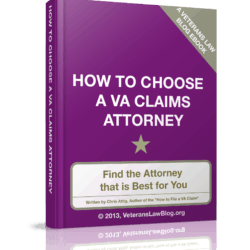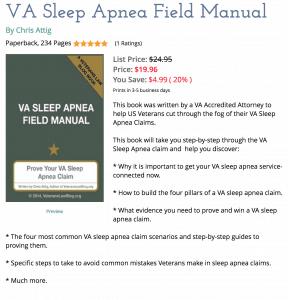I was at a Little League baseball game a few summers ago, and told one of my assistant coaches how we were still fighting for VA Benefits for a Vietnam Veteran.
He seemed shocked – not just at the fact that Veterans of a 40 year old war are still fighting for benefits, but also at the ridiculous number of VA Claims Process steps.
Most folks are shocked.
Their minds are blown when I tell them that my firm still gets calls from World War II Veterans and their Survivors being denied benefits by the VA
Why?
Most People Don’t Know all the VA Claims Process Steps.
Most people don’t even know that there are as many as 10-12 VA Claims Process Steps in most cases. They don’t know the hoops that Veterans have to jump through to get through all of the VA Claims Process Steps.
Most non-Veterans simply don’t have any concept of what a Veteran who is injured in military service has to go through to get health care, compensation, education benefits, and more.
This post outlines the VA Claims Process Steps that most Vets have to go through to get benefits. This process typically takes between 3 -8 years – and sometimes as many as 15 to 25 years for most Veterans.
That’s YEARS, not months.
My oldest step-son was in 2nd grade when I started representing one of my Veteran clients. Next fall he will be a junior in high school …. that’s the 11th Grade.
The Veterans claim is still working its way through the VA Hamster Wheel.
I started working with one of my clients right before my son was born in November 2012. He has learned to walk and to talk (sign language mostly, though) and the VA still hasn’t certified the Veteran’s appeal to the BVA.
There is plenty of blame to spread around, but the real problem is that the American people aren’t fed up with the – excuse the sharpness of my tongue – bullshit that our Vets go through to do anything about it.
I hope that Veterans and non-Veterans alike can use this post to have an education on what it’s like to be injured in a military war, only to return home to fight a war with the VA.
Step 1: The Original Claim.
All claims for benefits start with an original application.
You can file an application online – click here for a link in a new window to the VA’s online application process. You can also submit a VA Benefits Application by Mail.
In addition to “original claims”, there are also remanded claims, reopened claims, claims for increase, Survivor claims for Accrued Benefits, Survivor Claims for Dependency and Indemnity Compensation (DIC), pension claims, and much more.
The VA Builds a “Claims File” – the single most important document in any VA Claim. These C-Files, as they are called, are often 300-3,000 pages long, and the VA has NO organization in these files.
When I get them in from the VA Regional Office, they often remind me of the average high-school student’s locker – a hot mess of crumpled papers and notes.
Do you have your C-File? If not, find out how to get it.
Step 2: The VA Rating Decision.
After receiving your application, the VA will begin to develop evidence that will support or deny your claim.
This includes medical records (both in-service and post-service, VA medical records and private medical records), military service records, etc. A claims representative will review your claim and the supporting evidence and issue a “Rating Decision”.
If your claim is granted, the Rating Decision will tell you what claims were granted and what impairment rating was assigned to you, and the Effective Date of your benefits.
The VA often makes mistakes in determining the correct impairment rating; they also frequently assign the wrong “Effective Date” to your claim. The effect of these errors can often be that you are not receiving all the past and future money that you may be entitled to you.
Even if the VA grants your claim and starts paying you benefits, the Veteran needs to make sure that the VA properly decided your claim and is paying you the right amount of benefits.
If the VA claims representative denies your claim, you should get a Ratings Decision that explains the “reasons and bases” for the VA’s denial.
You will have one (1) year from the date that the Ratings Decision was sent to you to file a Notice of Disagreement (NOD) challenging the VA’s Rating Decision.
Step 3: The Veteran’s Notice of Disagreement (NOD).
The Notice of Disagreement – or the NOD – is the first step in filing an appeal. At a minimum, it must contain an “expression of dissatisfaction” with the Ratings Decision and an “intent to appeal”. I have found that there is so much more to add to the NOD.
In fact, it is my Firm’s philosophy that the biggest issues in most Veterans Benefits appeals can be resolved by having a competent attorney help file the NOD and represent the Veteran at a DRO conference.
Here are my thoughts on the Notice of Disagreement – called a NOD.
Step 4: The Decision Review Officer (DRO) review process.
When the Veteran files the Notice of Disagreement (NOD), the Veteran should request that a DecisionReview Officer (DRO) review the VA Ratings Decision.
The DRO is generally a more senior claims examiner, who has the authority to reverse the VA Rating Decision’s conclusion.
The DRO also has authority to meet and discuss the claim with the Veterans Benefits attorney or the Veteran.
I believe that the DRO process – with the exception of one “lone ranger bureaucrat” in the Waco VA Regional Office who shows visible disdain for the Veterans and the Veterans attorneys – yields more satisfactory results from the VA.
I believe major issues in a Veterans claims can be best resolved at the DRO conference.
Step 5: The VA’s Statement of Case (SOC).
The Statement of the Case (also known as the SOC) is statutorily required, and is prepared by the VA Regional Office.
It’s purpose is to explain to the Veteran the reason(s) that the Veteran’s claim for benefits was denied.
The Statement of Case (SOC) must provide notice to the Veteran of the relevant and/or controlling statutes and/or regulations on which the VA Regional Office relied to support its decision to deny benefits.
Take a look at this Video Screencast to watch me walk through a Statement of the Case Example and teach you what is most important about this claim.
Step 6: The Veteran’s Substantive Appeal – VA Form 9.
This is the big one for Veterans Appeals – if you’re going to spend some time drafting a form, this is the one you want to work on.
Why?
It lays out all of the issues you have with the VA Ratings Decision you are appealing. You can do it on multiple copies of VA Form 9, or with one copy of the form and continuation sheets.
State each decision from the VA Ratings Decision you disagree with.
State every reason why you disagree with that part of the decision. Don’t worry about being persuasive; here, the goal is to lay all your cards on the table. I often (but not always) add in the specific remedy that I want for each claim.
This really is a good point to consider contacting a VA Benefits Lawyer for help in your claim. There are traps for the unwary Veteran in filing a VA Form 9.
Step 7: The BVA Hearing.
The purpose of the BVA hearing is to give the BVA Hearings Official (Administrative Judge) an opportunity to hear witnesses, testimony and arguments in support of the Veteran’s appeal.
The hearings usually start with a summary of the issues – listen close, because Judges are humans too – sometimes they miss an issue that may be really important.
If you do decide to put in testimony, an oath will be administered by the BVA Judge to the witness.
The witnesses testimony will be recorded, and later added to a transcript of the hearing. We recommend that every Veteran request a copy of their hearing transcript from the BVA. They don’t charge the Veterans for these copies, and it is a good chance to review the hearing record to make sure that you said what you meant to say.
After the BVA Hearing, the Judge will issue a BVA Decision.
I have yet to see a BVA Decision that didn’t have an error in it – some of them are big errors that could affect the outcome, others are errors that are inconsequential to the case. There are five (5) possible outcomes:
1) Remand: The BVA decides that the VA Regional Office needs to develop the case better in some way, and so they “remand” it back to the Regional Office. These types of decisions are common.
I recently looked at one BVA Decision from the Little Rock VA Regional Office: the VA Ratings Decision was May 1998 – for the next 14+ years, it was caught in a seemingly endless loop of development at the Regional Office followed by Remand from the BVA back to the Regional Office to further develop the facts.
If your case has been remanded more than one (1) time by the BVA before the issuance of a final decision, you might want to consider having an attorney look at your VA Disability Benefits claim.
2) Reversal: The BVA decides that the VA Regional Office got it wrong, and they will issue a decision reversing the VA Regional Office Rating Decision. These types of decisions are very rare.
3) Affirmance: The BVA decides that the VA Regional Office got it right, and issue a decision affirming the VA Regional Office Rating Decision. These types of decisions are the most common kind.
4) Referral: The BVA sees an issue that the VA Regional Office hasn’t had a chance to address in a Ratings Decision (most commonly, when a Veteran raises a claim of Clear and Unmistakeable Error – or CUE for the first time at the BVA). The BVA will refer that claim only back to the VA Regional Office for filing and development.
5) Any combination of 1 – 4. The more issues you have in your claim, the more likely you are to get a BVA decision with 3 or 4 different outcomes.
If your claim is denied by the BVA, then you have three (3) choices:
Option 1: Request that the BVA Reconsider their decision. This usually doesn’t work. I have yet to see many cases where reconsideration at the BVA has really done the Veteran any good – although I’m sure that there is the “one-off” case like that out there.
Option 2: File a claim to reopen. This course of action is a good idea anytime that the BVA denies a claim or affirms the VA Regional Office denial of the claim. If you have New and Material Evidence (NME) that the BVA or the VA Regional Office did not consider, then you should file a claim to reopen as soon as possible.
Option 3: File an Appeal to the Court of Appeals for Veterans Claims (CAVC). You have 120 days from the date of the BVA’s decision (NOT the date you received it and NOT the date it was postmarked) to fil a Notice of Appeal in the Court of Appeals for Veterans Claims (CAVC).
Step 8: Appeal to the CAVC.
This option is discussed more in detail elsewhere in this blog:
— 8 Facts Veterans Should Know about the Court of Appeals for Veterans Claims.
— Don’t Fall for this Shell Game at the CAVC.
— CAVC lashes out at VA: Again, you failed to follow the law.
Step 9: Appeal to the Federal Circuit Court of Appeals.
Appeals to the Federal Circuit of Appeals on Veterans issues are rare. Successful appeals are even more rare.
This is not to say that you shouldn’t appeal an adverse CAVC appeal to the Federal Circuit Court of Appeals – it is to say that you really ought to have an experienced VA Benefits lawyer or experienced Fed Circuit Appellate lawyer to help you out.
Step 10: United States Supreme Court
If you receive an adverse decision at the Federal Circuit Court of Appeals, you can file a request to the Supreme Court to review that decision. The club of lawyers that argues at the Supreme Court is a small club – and while it’s on my professional “bucket list”, I am not currently a member of that club.
Point is – get an attorney – don’t go this level of appeal alone.
Step 11: Rinse and Repeat.
At any point in this process, the VA can bump you to the lower level, or up to the next level.
Or, the Veteran’s condition can worsen, leading to a “Claim for Increased Compensation.”
It really does feel like a game of “Chutes and Ladders” sometimes. With much more serious consequences.






